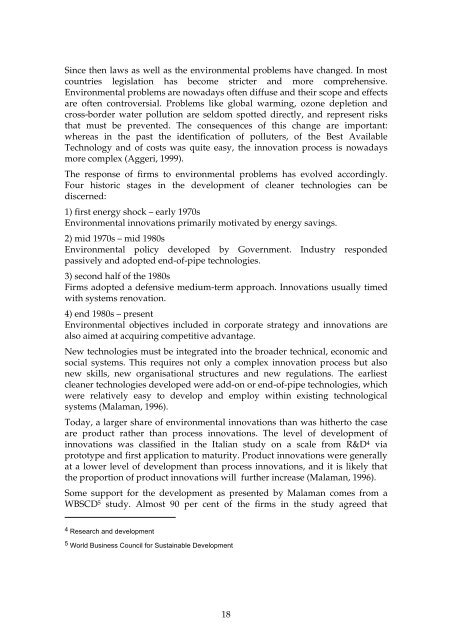Drivers of environmental innovation - Vinnova
Drivers of environmental innovation - Vinnova
Drivers of environmental innovation - Vinnova
Create successful ePaper yourself
Turn your PDF publications into a flip-book with our unique Google optimized e-Paper software.
Since then laws as well as the <strong>environmental</strong> problems have changed. In most<br />
countries legislation has become stricter and more comprehensive.<br />
Environmental problems are nowadays <strong>of</strong>ten diffuse and their scope and effects<br />
are <strong>of</strong>ten controversial. Problems like global warming, ozone depletion and<br />
cross-border water pollution are seldom spotted directly, and represent risks<br />
that must be prevented. The consequences <strong>of</strong> this change are important:<br />
whereas in the past the identification <strong>of</strong> polluters, <strong>of</strong> the Best Available<br />
Technology and <strong>of</strong> costs was quite easy, the <strong>innovation</strong> process is nowadays<br />
more complex (Aggeri, 1999).<br />
The response <strong>of</strong> firms to <strong>environmental</strong> problems has evolved accordingly.<br />
Four historic stages in the development <strong>of</strong> cleaner technologies can be<br />
discerned:<br />
1) first energy shock – early 1970s<br />
Environmental <strong>innovation</strong>s primarily motivated by energy savings.<br />
2) mid 1970s – mid 1980s<br />
Environmental policy developed by Government. Industry responded<br />
passively and adopted end-<strong>of</strong>-pipe technologies.<br />
3) second half <strong>of</strong> the 1980s<br />
Firms adopted a defensive medium-term approach. Innovations usually timed<br />
with systems renovation.<br />
4) end 1980s – present<br />
Environmental objectives included in corporate strategy and <strong>innovation</strong>s are<br />
also aimed at acquiring competitive advantage.<br />
New technologies must be integrated into the broader technical, economic and<br />
social systems. This requires not only a complex <strong>innovation</strong> process but also<br />
new skills, new organisational structures and new regulations. The earliest<br />
cleaner technologies developed were add-on or end-<strong>of</strong>-pipe technologies, which<br />
were relatively easy to develop and employ within existing technological<br />
systems (Malaman, 1996).<br />
Today, a larger share <strong>of</strong> <strong>environmental</strong> <strong>innovation</strong>s than was hitherto the case<br />
are product rather than process <strong>innovation</strong>s. The level <strong>of</strong> development <strong>of</strong><br />
<strong>innovation</strong>s was classified in the Italian study on a scale from R&D 4 via<br />
prototype and first application to maturity. Product <strong>innovation</strong>s were generally<br />
at a lower level <strong>of</strong> development than process <strong>innovation</strong>s, and it is likely that<br />
the proportion <strong>of</strong> product <strong>innovation</strong>s will further increase (Malaman, 1996).<br />
Some support for the development as presented by Malaman comes from a<br />
WBSCD 5 study. Almost 90 per cent <strong>of</strong> the firms in the study agreed that<br />
4 Research and development<br />
5 World Business Council for Sustainable Development<br />
18

















